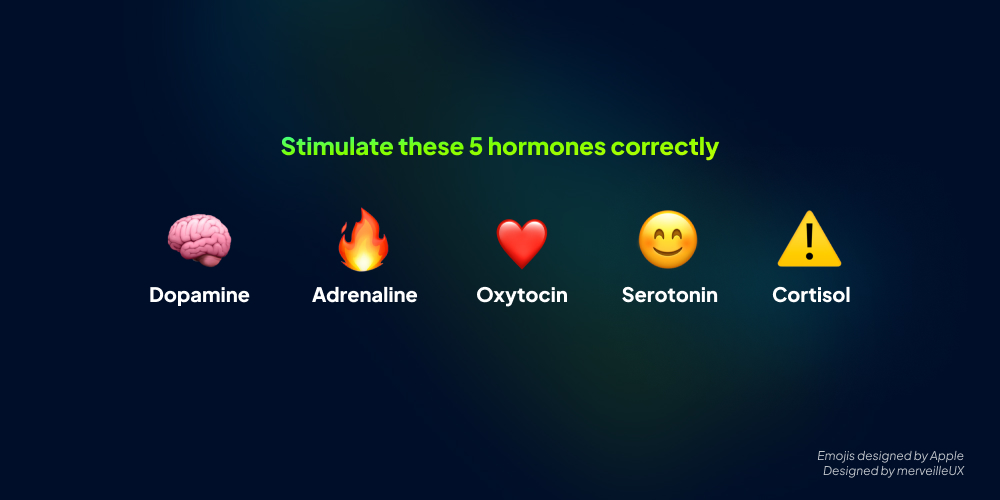Ever wonder what really makes users tick? It's more than just good design. Behind every click in your SaaS lies a complex cocktail of hormones that directly impacts engagement, retention, and revenue. Ready to unlock the secrets of these powerful chemicals? Let's dive into the 5 key hormones you need to know to create a truly addictive SaaS experience.
Table of contents
Dopamine: The Reward Hormone
Dopamine is often called the pleasure hormone, but it's more accurately the hormone of reward and motivation. It's released in anticipation of a positive event and drives us to repeat actions that have brought us pleasure.
How to Stimulate Dopamine in a SaaS Product?
-
Gamification: Incorporate gamification elements, like badges, points, leaderboards, or challenges, to reward users and encourage them to progress.
-
Positive Feedback: Use micro-interactions and animations to celebrate user achievements.
-
Clear Progression: Clearly display the user's progress within a task or project.
-
Personalized Notifications: Send relevant and personalized notifications.
-
Virtual or Real Rewards: Offer rewards for regular use of your SaaS product.
Example of Dopamine Stimulation in a Project Management SaaS
Imagine a project management SaaS used by a marketing team. A project manager has just finished planning a complex campaign involving numerous tasks, stakeholders, and deadlines.
Scenario without Dopamine Stimulation
The software simply displays a neutral message: "Project saved." The project manager feels relieved to have finished the task, but nothing more. The experience is functional but not particularly rewarding.
Scenario with Dopamine Stimulation
As the project manager clicks "Save," a subtle animation appears: virtual confetti falls on the screen, accompanied by a personalized message: "Congratulations! Your 'Product X Launch' campaign is ready for takeoff. You've planned 25 tasks, involving 7 team members. Ready for success?"
This stimulation will encourage the user to relive this experience and therefore complete their tasks again.
Adrenaline: The Excitement Hormone
Adrenaline, often associated with stress, is actually the hormone of excitement, action, alertness, and resource mobilization. It's released in the face of a challenge, competition, emergency, or any situation requiring a quick and effective response. In the context of a SaaS product, adrenaline can be a valuable ally, but its use must be carefully managed to avoid generating negative stress.
How to Use Adrenaline Positively in a SaaS Product?
-
Create Engaging Challenges and Goals: Offer optional challenges, levels to reach, or rewards to stimulate user engagement and motivation.
-
Incorporate Competitive Elements (in Moderation): Leaderboards, badges, or comparisons with other users can stimulate adrenaline and competitiveness. However, ensure the competition remains healthy and encouraging, without generating frustration or excessive stress.
-
Offer Emergency Features: If your SaaS allows, provide features that enable users to react quickly and effectively in critical situations. For example, an alert button, a priority notification system, or quick access to essential information.
-
Gamification and Immediate Rewards: Use gamification mechanics to reward quick and effective actions by providing immediate feedback to the user.
Example of Adrenaline Stimulation in a Customer Support SaaS
Imagine a customer support SaaS used by a team of agents. An agent receives an urgent notification: a VIP client is experiencing a critical issue blocking their activity and is threatening to cancel their contract if they don't get a solution quickly.
Scenario without Adrenaline Stimulation
The software simply displays the notification among others, with no particular distinction. The agent sees it but isn't immediately alerted to the urgency of the situation. They might treat it as a regular ticket and not react quickly enough.
Scenario with Adrenaline Stimulation
The VIP client's notification appears flashing red, accompanied by a discreet but distinctive alert sound. The software automatically highlights the VIP client's ticket and displays a countdown timer indicating the time elapsed since the request. A flashing "Take Charge" button prompts the agent to react immediately. Clicking it takes the agent directly to the problem-solving interface, with all the necessary information readily available.
This well-managed adrenaline stimulation allows the agent to react quickly and effectively to a critical situation. The experience, while potentially stressful, is perceived as stimulating and rewarding because it allows the agent to demonstrate their skills and save the day. Adrenaline, in this case, becomes a factor of performance and job satisfaction.

Oxytocin: The Bonding Hormone
Oxytocin is often called the love or bonding hormone. It plays a vital role in social relationships, trust, empathy, and cooperation. In the context of SaaS, stimulating oxytocin can strengthen the bond between the user and the software, foster a sense of community, and improve customer satisfaction.
How to Stimulate Oxytocin in a SaaS Product?
-
Personalization and Human Interaction: Use warm and empathetic language in your messages and notifications. Personalize the user experience based on their preferences and history. Incorporate human elements, such as team photos or customer testimonials.
-
Caring and Responsive Customer Support: Fast, efficient, and empathetic customer support can generate feelings of trust and appreciation in the user. Prioritize human and personalized interactions over automated, impersonal responses.
-
Collaboration and Sharing: If your SaaS allows, incorporate collaboration and sharing features between users. Facilitating communication, discussions, and teamwork can stimulate oxytocin and strengthen the sense of community.
-
Community and Online Events: Organize webinars, workshops, or online forums to create a space for exchange and sharing among users. These events can strengthen social bonds and foster a sense of belonging.
-
Recognition and Appreciation: Recognize and appreciate user contributions, whether through thank you messages, badges, special mentions, or rewards.
-
Transparency and Authenticity: Communicate transparently and authentically with your users to build trust and create a more human connection.
Example of Oxytocin Stimulation in a Collaborative Content Creation SaaS
Imagine a SaaS that allows writers, graphic designers, and project managers to collaborate on creating marketing content. A team has just finalized a major project after several weeks of intense work.
Scenario without Oxytocin Stimulation
The software simply displays a message: "Project completed." Team members receive an individual email notification. The experience is functional but impersonal and not very rewarding on a human level.
Scenario with Oxytocin Stimulation
Once the project is marked as complete, a collaborative animation appears on the screen of all team members. Personalized avatars of the collaborators virtually come together to celebrate the project's success. A personalized message appears: "Congratulations to the whole team! You've done an outstanding job on the 'New Marketing Campaign' project. Thank you for your collaboration and commitment!"
By stimulating oxytocin, the SaaS transforms a simple functional notification into a positive and rewarding experience on a human level. Team members feel valued, connected, and motivated to collaborate again on future projects. This sense of belonging and trust is a key factor in success and long-term loyalty.
Serotonin: The Happiness Hormone
Serotonin is a hormone essential for well-being, self-confidence, and a sense of belonging. It plays a significant role in regulating mood, sleep, and appetite. In the context of a SaaS product, stimulating serotonin can improve the user experience, foster engagement, and build customer loyalty.
How to Stimulate Serotonin in a SaaS Product?
-
Sense of Accomplishment: Allow users to achieve their goals easily and efficiently. Break down complex tasks into smaller, more manageable steps. Celebrate successes, even small ones, with congratulatory messages and rewards.
-
Social Recognition: Integrate features that allow users to share their achievements and receive positive feedback from their peers or the community. Implement rating systems, comments, likes, or badges.
-
Sense of Belonging: Create an online community around your SaaS. Organize events, discussion forums, or user groups. Encourage interaction and sharing among users.
-
Control and Mastery: Give users a sense of control over their experience. Offer customization options, backup and restore features, and notification management tools. An intuitive and easy-to-use interface also contributes to the feeling of mastery.
-
Aesthetics and Pleasing Design: Pay attention to the aesthetics of your SaaS. Use colors, typography, and images that are pleasing to the eye. Create a harmonious and intuitive user interface.
-
Positive and Inspiring Content: If your SaaS allows, incorporate positive and inspiring content, such as motivational quotes, success stories, or tips for improving productivity.
Example of Serotonin Stimulation in a Habit Tracking SaaS
Imagine a SaaS designed to help users track their daily habits, such as exercising, meditating, or reading. A user has just completed a full week of meeting their daily meditation goal.
Scenario without Serotonin Stimulation
The software simply displays a neutral message: "Week complete." The user sees that they've reached their goal, but nothing more. The experience is functional, but not very rewarding.
Scenario with Serotonin Stimulation
As the user confirms their last meditation session of the week, an animation appears on the screen: virtual fireworks celebrate their achievement. A personalized message is displayed: "Congratulations! You've reached your daily meditation goal for a whole week! Your perseverance is paying off. Keep it up!"
In addition to the animation and congratulatory message, the software unlocks a new, more advanced level of guided meditation to encourage the user to continue their progress.
By combining these elements, the SaaS transforms a simple functional notification into a positive and rewarding experience, stimulating serotonin and strengthening the user's engagement and motivation.
Cortisol: The Stress Hormone
Cortisol, often called the stress hormone, plays a crucial role in the body's response to perceived threats and challenges. While some cortisol is essential for proper bodily function, excessive or prolonged release can have negative consequences for your SaaS users, impacting their engagement, productivity, and overall satisfaction.
How to Minimize Cortisol and Optimize the User Experience?
-
Simplicity and Clarity: Design an intuitive and easy-to-navigate user interface. Minimize the steps required to perform common tasks and provide clear and concise instructions.
-
Performance and Reliability: Ensure your SaaS is fast, reliable, and bug-free. Slow loading times, errors, and crashes can generate frustration and stress for users.
-
Efficient and Empathetic Customer Support: Provide accessible, responsive, and empathetic customer support. Help users resolve their issues quickly and efficiently, demonstrating understanding and patience.
-
Control and Autonomy: Give users a sense of control over their experience. Offer customization options, backup and restore features, and notification management tools.
-
Transparency and Communication: Communicate clearly and regularly with your users. Keep them informed of updates, changes, and potential issues. Transparency builds trust and reduces uncertainty, which can help decrease stress.
Example of Cortisol Management in a Personal Finance SaaS
Imagine a SaaS designed to help individuals manage their budget, investments, and taxes. A user is trying to file their income taxes using the software for the first time.
Scenario without Cortisol Consideration (High Stress)
The interface is complex and overloaded with information. Navigation is difficult, and the user struggles to find the forms and information they need. Technical terms are numerous and unclear. The user feels overwhelmed, frustrated, and stressed. They are likely to abandon the task and not use the software again. Their cortisol levels increase.
Scenario with Cortisol Consideration (Reduced Stress)
The software offers a user-friendly virtual assistant that guides the user step-by-step throughout the filing process. The interface is clean, uncluttered, and intuitive. Information is presented simply and accessibly, with clear explanations of technical terms. Contextual tips and tricks are offered to help the user optimize their tax filing. An automatic save system reassures the user and eliminates the fear of losing their data. A live chat feature allows the user to contact an advisor if needed. The user feels confident and in control. Their cortisol levels remain low.
In the second scenario, the user experience is smooth, intuitive, and reassuring. The user feels supported and confident. They are more likely to use the software again and recommend it to others. By reducing stress and frustration, the SaaS fosters user engagement and loyalty.
Conclusion
Optimizing the user experience of your SaaS product requires a thorough understanding of the hormonal mechanisms that influence emotions and behaviors. By practicing emotional design and incorporating elements that stimulate dopamine (reward), adrenaline (motivation in action), oxytocin (connection and collaboration), and serotonin (well-being and accomplishment), while minimizing stress factors that generate cortisol, you can create a more engaging, stimulating, and loyalty-building digital environment. It's important to emphasize that the secretion of these five hormones is complex and influenced by numerous factors. Design ethically: remember that the goal is not to manipulate your users but to create a positive and respectful experience that benefits everyone. A happy and engaged user is a loyal user, and loyalty is the key to success for any SaaS product.



